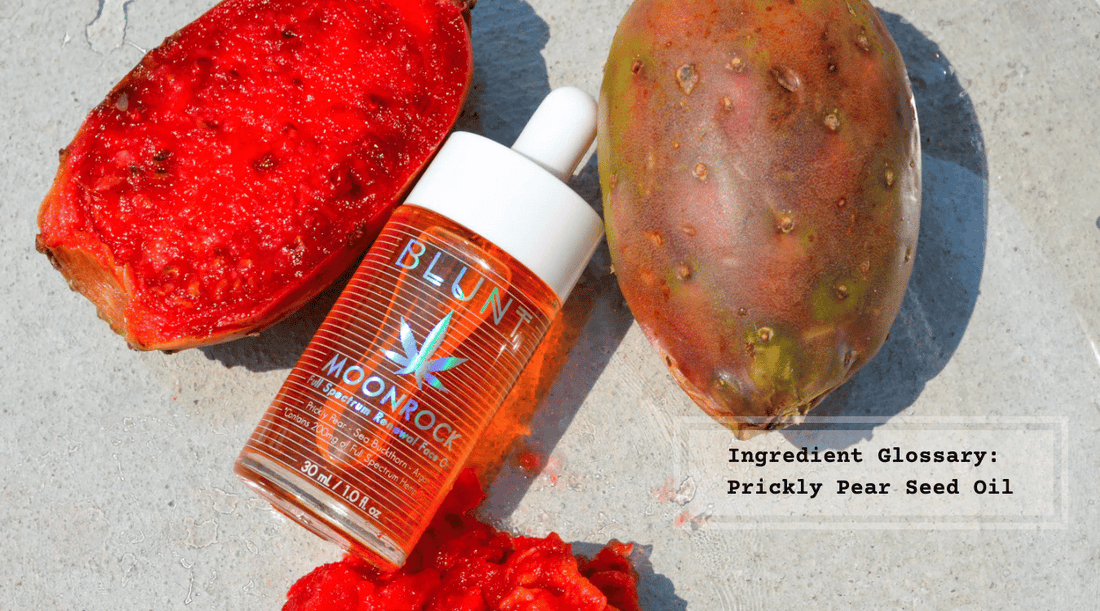Table of Contents:
- Prickly Pear Oil Benefits: What Is It?
- Prickly Pear Oil Benefits: Why Is It So Expensive?
- Prickly Pear Oil Benefits: What's It Made Of
- Prickly Pear Oil Benefits In Skincare: The Top 3
- Experience Prickly Pear Oil Benefits With Blunt’s Moonrock CBD Facial Oils
You heard it here first, folks: prickly pear oil benefits are slaying the skincare game. For the newbies, it's a moisturizing and soothing oil derived from the prickly pear cactus. Known as a protectant, prickly pear seed oil is brimming with antioxidants, making it one of the most powerful and rejuvenating natural skincare ingredients out there.
This Blunt blog presents you with all the facts about prickly pear oil benefits and recommends one of our own CBD facial oils that utilizes it's power as an ingredient:
Prickly Pear Oil Benefits: What Is It?

Derived from the prickly pear cactus, prickly pear oil is also known as barbary fig oil or Indian fig oil. They can reach up to seven feet in height and, like other cacti, have spines called glochids. Its' fruit is sought after for the very small black seeds it contains. Later, they're cold-pressed so we can reap all the prickly pear oil benefits in our skincare routines (and in Blunt's CBD facial oils).
While the plant is originally native to Mexico, you can find it amongst many arid and semi-arid areas of the world, like Morocco. Its ability to thrive and produce fruit in those dry climates has earned it a reputation as "the miracle plant," but the prickly pear oil benefits don't just end with where it grows; it's a superfood, too.
Historians have found that some cultures have known about the prickly pear oil benefits for centuries, with different groups of people finding their own unique uses. For example, the Aztecs used prickly pear to treat burns, while the Chinese dressed abscesses with it. In North America, Native Americans made a syrup out of it to ease ailments like asthma, diabetes, and high cholesterol.
More recently, prickly pear seed oil has become the “it girl” in the skincare realm.
Prickly Pear Oil Benefits: Why Is It So Expensive?
Before we get into the prickly pear oil benefits, let's go over the extraction process:
Extraction is a laborious and time-consuming process, as it takes over 1 million seeds to produce a single liter of oil in about 36 hours. Adding to the difficulty, each prickly pear fruit boasts a minuscule 150-300 seeds on average. And even then, the seeds only contain about 5% oil.
During the production process of prickly pear oil, the seeds are separated from the pulp, washed, air-dried, and stored in a cool, dry place before being cold-pressed. Because of the strenuous cultivation process, prickly pear oil is costly. But, luckily, it's an incredibly sustainable crop.
Prickly Pear Oil Benefits: What's It Made Of?

It's true: the prickly pear oil benefits are plenty. In fact, compared to most beauty oils on the market, it contains the highest percentage (88%) of unsaturated fatty acids. These saviors can stimulate healthy cell production and turnover.
Adding to its benefit roster, prickly pear seed oil also contains the highest level of tocopherol, or vitamin E, that protects your skin and helps it to retain moisture. Want to know a cool fact? It has almost 150% more tocopherol than Argan oil.
Prickly Pear Oil Benefits In Skincare: The Top 3
Check out these 3 prickly pear oil benefits you (and your skin) need to know about:
Prickly Pear Oil Benefits: It Can Reduce the Appearance of Fine Lines and Wrinkles
It’s no secret that prickly pear oil is a rich source of antioxidants, fatty acids, phytosterols, and vitamins E and K – all of which can reduce the appearance of fine lines and wrinkles. The protective antioxidants in prickly pear oil can also encourage new collagen production, while helping skin that’s been exposed to environmental stressors (things like free radicals that may boost signs of aging).
Prickly Pear Oil Benefits: It Can Soften, Smooth, and Hydrate Your Skin
Did you know prickly pear oil is a natural emollient containing phospholipids and phytosterols to give your skin lasting moisture? More so, the linoleic acid in prickly pear seed oil can also help your skin retain water for added hydration. Since it's known for having the highest vitamin E content of all plant oils (as we discussed above), it may provide your skin with TLC, nourishment, and a natural radiance.
Prickly Pear Oil Benefits: It Can Ease Inflammation
Prickly pear oil may be effective in aiding acute inflammation thanks to its bioactive compounds of fatty acids, vitamins E and K, and phytosterols. It does this by regulating your skin's inflammatory mediators and oxidative stress markers. Prickly pear oil’s impressive anti-inflammatory and antimicrobial properties can also help wounds heal faster, repair UV damage, and fade scars.
Experience Prickly Pear Oil Benefits With Blunt’s Moonrock CBD Facial Oils

Blunt Skincare is proud to be a pioneer of prickly pear oil as it’s a rare and unique ingredient that provides your skin with next-level benefits. This is the reason we've formulated it into one of our CBD facial oils: AKA the Moonrock Full Spectrum Renewal Face Oil.
Here is what your skin can expect with Moonrock:
- Full-spectrum CBD-rich hemp extract to enhance its ability to fight against free radicals and inflammation
- Multivitamin blend of Prickly Pear, Sea Buckthorn, and Argan to boost its health and promote repair
- Healthy, fresh-feeling skin that's radiant and vitalized
BLUNT PROTIP: We recommend adding our Moonrock CBD facial oils into your routine after water-based treatments for even more skin-loving effectiveness.
Which of the three prickly pear oil benefits were you the most surprised to learn?

